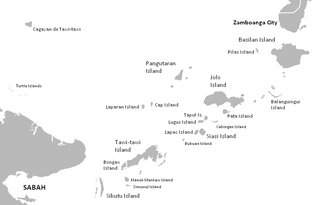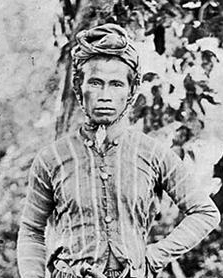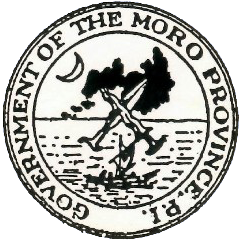
The Sulu Archipelago is a chain of islands in the Pacific Ocean, in the southwestern Philippines. The archipelago forms the northern limit of the Celebes Sea and southern limit of the Sulu Sea. The Sulu Archipelago islands are within the Mindanao island group, consisting of the Philippines provinces of Basilan, Sulu, and Tawi-Tawi; hence the archipelago is sometimes referred to as Basulta, derived from the first syllables of the three provinces.

The Moro Rebellion (1902–1913) was an armed conflict between the Moro people and the United States military during the Philippine–American War. The rebellion occurred after the conclusion of the conflict between the United States and First Philippine Republic, and saw the US move to impose its authority over the Muslim states in Mindanao, Jolo and the neighboring Sulu Archipelago.

The Sultanate of Sulu was a Sunni Muslim state that ruled the Sulu Archipelago, coastal areas of Zamboanga City and certain portions of Palawan in the today's Philippines, alongside parts of present-day Sabah and North Kalimantan in north-eastern Borneo.

The Tausūg, are an ethnic group of the Philippines and Malaysia. A small population can also be found in the northern part of North Kalimantan, Indonesia. The Tausūg are part of the wider political identity of Muslim Filipinos of western Mindanao, the Sulu archipelago, and southern Palawan, collectively referred to as the Moro people. The Tausugs originally had an independent state known as the Sultanate of Sulu, which once exercised sovereignty over the present day provinces of Basilan, Palawan, Sulu, Tawi-Tawi, Zamboanga City, eastern part of Sabah and northeastern part of North Kalimantan. They are also known in the Malay language as Suluk.

Jolo, officially the Municipality of Jolo, is a municipality and capital of the province of Sulu, Philippines. According to the 2020 census, it has a population of 137,266 people.

The Moro people or Bangsamoro people are the 13 Muslim-majority ethnolinguistic Austronesian groups of Mindanao, Sulu, and Palawan, native to the region known as the Bangsamoro. As Muslim-majority ethnic groups, they form the largest non-Christian population in the Philippines, and according the 2020 census conducted by the Philippine Statistics Authority, they comprise about 6.4% of the country's total population, or 6.9 million people. However, the National Commission on Muslim Filipinos (NCMF) estimates that the population is closer to about 11% of the country's total population, or 10.7 million people, attributing the difference to a number of factors.

The Maguindanaon people are an Austronesian ethnic group from the Philippines. The Maguindanaon are part of wider political identity of Muslims known as Moro, who constitute the third largest ethnic group of Mindanao, Sulu and Palawan. The Maguindanaons constitute the ninth largest Filipino ethnic group and are known for being distinguished in the realm of visual art. They have been renowned as metalworkers, producing the wavy-bladed keris ceremonial swords and other weapons, as well as gongs. The Maguindanaons historically had an independent sultanate known as the Sultanate of Maguindanao which comprises modern day Maguindanao del Norte, Maguindanao del Sur, Zamboanga Peninsula, Davao Region and Soccsksargen. The name "Maguindanao/Magindanaw" itself was corrupted by Spanish sources into "Mindanao", which became the name for the entire island of Mindanao.

The Sultanate of Maguindanao was a Sunni Muslim sultanate that ruled parts of the island of Mindanao, in the southern Philippines, especially in modern-day Maguindanao provinces, Soccsksargen, Zamboanga Peninsula and Davao Region.

Luis Pérez Dasmariñas y Páez de Sotomayor was a Spanish soldier and governor of the Philippines from December 3, 1593 to July 14, 1596. In 1596, he sent unsuccessful expeditions to conquer Cambodia and Mindanao.

Francisco de Tello de Guzmán was Spanish governor of the Philippines from July 14, 1596 to May 1602. He was a knight of the Order of Santiago.

The Spanish–Moro conflict was a series of battles in the Philippines lasting more than three centuries. It began during the Spanish Philippines and lasted until the Spanish–American War, when Spain finally began to subjugate the Moro people after centuries of attempts to do so. Spain ultimately conquered portions of the Mindanao and Jolo islands and turned the Sultanate of Sulu into a protectorate, establishing geographic dominance over the region until the Spanish-American War. Moro resistance continued.
Sultan Batara Shah Tengah was the 8th Sultan of Sulu. He reigned from 1596 to 1608. He was the son of the previous Sultan Muhammad ul-Halim, also known as Pangiran Buddiman.

Datu Ali was the Rajahmuda of Tinungkup within the Sultanate of Buayan before succeeding his cousin, Datu Uto, as Rajah of Buayan formally from Uto's death in 1902 until his death in 1905. He was the cousin of Datu Uto of Buayan and brother of Datu Djimbangan and Sultan Tambilawan of Kudarangan, and as a rising leader, Datu Ali overpowered his brothers to rule over Kudarangan.

Datu Djimbangan (Guimbangan or Jimbangan) - known as Midted Sa Inged (Superintendent of the polity) of the Sultanate of Kudarangan, is the son of Sultan Bayao Bin Sultan Maitum, cousin of Datu Uto and elder brother of Sultan Tambilawan of Kudarangan and adviser to Datu Ali in the war against Pre-Spanish and the Pre-Americans Era. Datu Djimbangan lives at the old Spanish fort of Libungan, his only claim to distinction as he has but a small following. He is also known to Kabuntalan nobles as Datu Masbud (fat) because he was considered to be very fat, hot tempered and inclined to be unreconstructed. He was also known as the thievish chieftain to the Spanish Governor of Cotabato for that once could come to Datu Djimbangan's hand might well counted as lost.

Najeeb Mitry Saleeby (1870-1935) was a Lebanese-American physician who served the U.S. colonial occupation of the Philippines and who became an expert on and advocate for the Muslim population of the region. He held positions as the Assistant Chief of the Bureau of Non-Christian Tribes, Superintendent of Schools, and Captain and Assistant Surgeon of the US Volunteers. He became a premier expert on the Moros, Muslim peoples from the islands of Mindanao and Sulu. Through his medical profession, advocacy for bilingual education, and critique of American imperialism, he dedicated his career to advancing Filipino welfare. He spent most of his adulthood in the Philippines and died in Baguio in 1935.
The Sulu Expedition of 1602 was an unsuccessful military campaign by the Spanish Empire to capture the island of Jolo. Launched from the Spanish Philippines to suppress Sulu pirates, the expedition ended in failure.
The Sulu Expedition of 1630 was an unsuccessful military campaign by the Spanish Empire to capture the island of Jolo. Launched from the Spanish Philippines to suppress Sulu pirates, the expedition ended in failure.
The raids of Visayas took place in 1599 and 1600. The allied Moro fleets of Maguindanao, Buayan and Sulu conducted two raids on the Spanish-held islands of Visayas.

The Sino-Spanish conflicts were a series of conflicts between the Spanish authorities of the Spanish Empire and its Sangley Chinese residents in Spanish Philippines between the 16th and 18th centuries, which led to the Chinese assassinations of two Spanish governor generals, assassination of Spanish constables, Spain permanently losing Maluku under threat of Chinese attack, and massacres of the local Sangley Chinese residents due to generalized Anti-Chinese paranoia by the then ruling Spanish governor-generals.

Mohammad Pulalun Kiram was sultan of Sulu from 1844 to 1862. He succeeded his father, Jamalul Kiram I. During his reign, Spanish expedition to Sulu was led by Governor-General Narciso Claveria y Zaldua and subsequent conflict with the Spanish military under Governor-General Juan Antonio de Urbiztondo. As sultan, he was known for his political administration making the Royal House of Kiram extend its influence and fame among Sulus.















